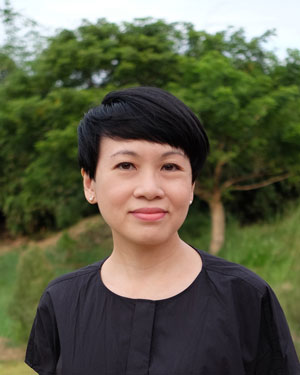INTERVIEW: SAM I-SHAN
Sam I-shan is a curator with an interest in time-based media, photography, and art and politics. With fifteen years’ experience in art institutional settings, she was previously curator at National Gallery Singapore, Singapore Art Museum and Esplanade Visual Arts. Her monographic, research-focused exhibitions at NGS include the Ng Teng Fong Roof Garden Commission: Cao Fei, and Georgette Chen: At Home in the World. At Esplanade, she curated and managed new commissions and site-specific exhibitions, working with a range of regional artists. Her exhibitions at SAM include Afterimage: Contemporary Photography in Southeast Asia. She also headed film and moving image initiatives there, specialising in Artist Films, and co-programming the annual Southeast Asian Film Festival. She lives and works in Singapore and Cambodia.
How did you start curating art?
I worked in an art institutional context for many years, and was fortunate to be given the platform to work on a variety of exhibitions, including gallery exhibitions, festival presentations, public commissions and so forth. It was a privilege to learn on the job, and work with a wide variety of artists, collections, institutions and collectors. Outside (and sometimes within) the institutional setting, I also worked on independently-conceived exhibitions and projects with friends and collaborators.
How would you describe your curatorial approach?
It depends on the exhibition or project, but in general I am led very much by artists’ practices, as well as artworks. I find the process of working with artists very rewarding, whether they are at a transitional point in their established practice, just starting out with something strong to say, or simply working through a new project. At other times, it may be a particular artwork or body of work that I am drawn to, and build an exhibition around.
Personally, I tend not to abide by a theme or topic, even if it might spark off the project, unless I am compelled to by a brief. I certainly have long-standing interests and questions that may guide my approach, but I find it more invigorating to use an exhibition concept rather as a parameter, and see where the artworks and artists take us.
Curating or organising an exhibition is a creative process and an opportunity to explore ideas, perspectives and emotions. Particular intentions or positions may internally govern my approach to a given project, but I prefer that an exhibition is non-prescriptive and supports multiple readings, because there are always people who know and see things that I do not.
Questions of form are also important as an exhibition is realised in space and time. For instance, if we are working in a physical space, it is critical to think through visual juxtapositions, narrative routes, sight lines, durationality and so forth. At other times, it may be temporally based like a moving image programme, or perhaps even virtual. It is very interesting to work with form and genre in a way that is true to, or expands upon an artwork, and an artist’s practice.
Exhibitions themselves are ontological experiences. They propose a particular order of things and in the broadest sense, ask questions about what it means to be and exist in the world.
Did mentorship play a part in your curatorial journey? If so, how?
I have been fortunate to work with practitioners of all backgrounds who are generous with their knowledge and experience and these include artists, as well as seniors, peers and neophytes in the field, who teach me so much. Every single person has their area of expertise and one can learn a lot, through questions, observation, and an attitude of curiosity and openness.
What kind of curatorial projects excite or inspire you?
I am inspired by projects that propose new approaches to working across disciplines, in ways that are deeply considered about the inherent qualities of these genres, but inventive about the possibilities they offer.
I am drawn to research-based projects, and excited to see how these can be substantively yet creatively realised in the form of an exhibition, as it is not an easy task.
I am impressed by projects that reveal points of view that are original or inimitable, but are also aware about their context and place in history.
In short, it is always delightful to encounter an exhibition that leaves me better off than before in one way or another.
Apply for Curator Open Call here.
Deadline: 20 March 2022

